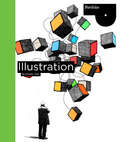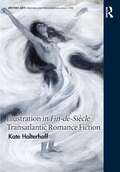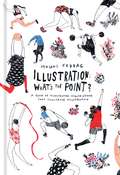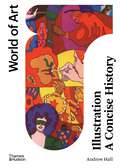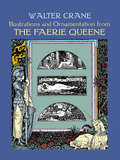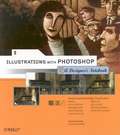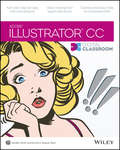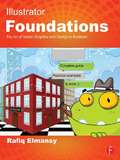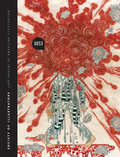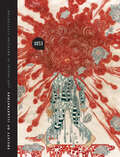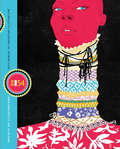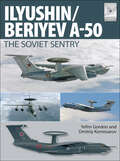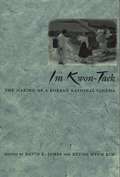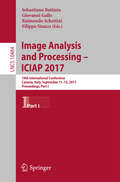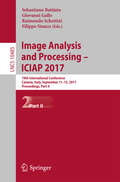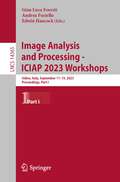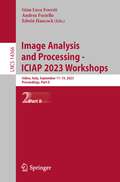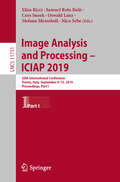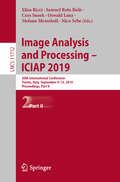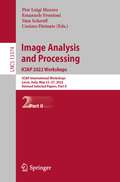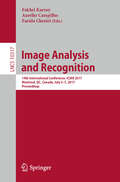- Table View
- List View
Illustration (Portfolio)
by Andrew HallThis broad introduction to illustration reveals the artistic, intellectual and organizational skills needed to practice as a freelance illustrator, and helps the reader navigate the specialist areas of its application. There is a practical introduction to image-making, covering ways of drawing, viewpoints and perspective, colour palettes and choice of media, along with an examination of how illustration communicates through metaphor, symbolism, wit, narrative, and more. Chapters devoted to editorial, publishing, corporate/advertising and the entertainment industry introduce the reader to the nature and function of different types of illustration, tracking the progress of real-life commissions and presenting a gallery of examples of contemporary work. The book also addresses practical considerations when setting up a working environment, from the design of the workspace – lighting, computer equipment and basic tools – to time management and collaborative working.
Illustration in Fin-de-Siècle Transatlantic Romance Fiction (British Art: Histories and Interpretations since 1700)
by Kate HolterhoffThis book examines illustrations created to accompany fictions written by several of the most popular authors published in Britain and America between 1885 and 1920. By studying the lavish illustrations that complemented not only initial serializations, but also subsequent publications of fictions by H. Rider Haggard, Rudyard Kipling, James De Mille, Robert Louis Stevenson, and H. G. Wells, the book demonstrates the significance of images to the fin de siècle romance form. In order to make fantastic plots seem possible, graphic artists worked hand in hand with authors to not only fill gaps in audience understanding, but also expand and deepen the meaning of these marvels. The book will be of interest to scholars working in art history, visual culture, illustration studies, British and American history, and British and American literature.
Illustration: A Book of Illustrated Illustrations that Illustrate Illustration
by Mouni FeddagOf all the graphic arts, illustration is currently the most dynamic and exciting. In every medium - advertising, book publishing, product design, houseware and home furnishings - new talents are emerging, making their mark and (in some cases) a fortune out of their illustration skills.But why? In this uniquely presented book, gifted illustrator Mouni Feddag takes on the subject and gives it the treatment it deserves. Witty, dynamic, wide-ranging and visual, this title answers the big questions that illustration throws up, including: What's the point of hand-drawn things?What's the point of pictures?What's the point of looking good?What's the point of decoration?What's the point of commercial art?What's the point of repetition?
Illustration: A Concise History (World of Art)
by Andrew HallAn indispensable guide to the international history of illustrated images, from 1750 to the present day. Illustration: A Concise History is a dynamic visual journey through the landscape of illustration that maps the evolution of the discipline from the industrial revolution to the postdigital age and showcases over 180 of its most iconic practitioners, including Laura Knight, Antonio Lopez, Käthe Kollwitz, and Hayao Miyazaki. By contextualizing the subject within a framework of key political events, cultural innovations, and technological advances, Andrew Hall redefines how we might think about illustration and the place that it has in our ever-evolving global network. The second half of this introductory volume follows on from the ten chapters charting the chronology of illustration to provide a more in-depth look at its specific commercial genres across eleven feature sections, each including minihistories, practical career advice, and biographies of inspirational practitioners who operated within the field.
Illustrations and Ornamentation from The Faerie Queene
by Carol Belanger Grafton Walter CraneThis anthology's magnificent illustrations and decorations in the medieval style were created by famed artist Walter Crane in the 1890s to illustrate a sumptuous multivolume limited edition of The Faerie Queene, Edmund Spenser's sixteenth-century allegorical epic poem. A tribute to Queen Elizabeth I, the poem celebrates holiness, temperance, chastity, friendship, and other virtues in verse tales of knightly adventure, courtly love, and acts of gallantry. Crane created these 352 magnificent illustrations and decorations in the rich nineteenth-century style of neo-medievalism made famous by William Morris and his Kelmscott Press, with which Crane was associated.Crane's designs have been meticulously reproduced here, including striking images of gallant knights in armor, demure maidens, fearsome dragons, unicorns, angels, and a host of decorative elements -- all displayed in a rich variety of full-page plates, finely detailed borders, and exquisite vignettes. Also included are charming headpieces, tailpieces, decorative initials, and the exquisite typography that originally appeared within the borders and other areas.Sure to delight any admirer of Crane's dazzling style, this splendid archive, skillfully arranged by Carol Belanger Grafton, will also provide a wealth of inspiration and immediately usable graphics for artists and illustrators alike.
Illustrations with Photoshop: A Designer's Notebook
by William RodarmorWorld-renowned French artists share their exciting and innovative digital creations in Illustrations with Photoshop: A Designer's Notebook , a first-time English translation of the cutting-edge French work. The images in this book will energize image professionals, graphic artists, photographers, computer graphics designers--all creators of images, whether still or animated--and will forever change the way you see and perform your design work. Photoshop is best known among photographers as a photographic image manipulation tool; it is used largely for retouching and photomontage. But Photoshop is also a powerful and highly sophisticated tool for creating quality digital drawings and artwork. Artists, like the ones showcased within, use it to realize their unique vision through illustration. In this lavish, full-color collection, nine French graphic artists--well-known professionals from a vibrant culture with a reputation for taking creative risks and producing incomparable graphics and art--are turned loose with Photoshop. Ranging from advertising to children's book illustration, science fiction to settings for graphic novels and role-playing games, their groundbreaking creations will inspire you to see your industry anew, appreciate graphic design from a changed perspective, and revitalize your work. Representing the very finest of French creation in the world of graphic design and digital imaging, this notebook leads you into the heart of each author's artistic approach, guiding you through the inception and making of nine unparalleled works of art that spring from widely varying sources of inspiration. But you'll come away with more than ideas and inspiration--you'll find detailed, step-by-step information on making Photoshop do anything and everything you want to accomplish your ideal digital illustration. Unlike any other available, this visually stunning book will give you the creative license and technical know-how you need to create one-of-a-kind digital illustrations with Photoshop that are limited only by your imagination.
Illustrator CC Digital Classroom (Digital Classroom)
by Jennifer Smith AGI Creative TeamA complete training package lets you learn Adobe Illustrator CC at your own speed Adobe Illustrator is the leading drawing and illustration software used to create artwork for a variety of media. This book-and-DVD package provides 13 self-paced lessons that get you up to speed on the latest version of Illustrator (Creative Cloud). Step-by-step instructions in the full-color book are supported by video tutorials on the DVD. Together, these tools will help you learn Adobe Illustrator basics, essential skills, and all the new capabilities in Illustrator CC—in no time. • Includes step-by-step instructions in a book-and-DVD training package • Features expert instructors who guide you through 13 lessons that prepare you to create fabulous artwork with Illustrator • Covers beginning through intermediate-level skills Illustrator CC Digital Classroom is like having your own personal tutor to help you learn the latest version of Illustrator. Note: DVD and other supplementary materials are not included as part of the e-book file, but are available for download after purchase.
Illustrator Foundations: The Art of Vector Graphics, Design and Illustration in Illustrator
by Rafiq ElmansyWhether you are creating a catchy and fun cartoon, designing a print banner advertisement, or developing content for a mobile game, save time and money with expert techniques, trips and tricks from by Adobe Certified Expert, Rafiq Elmansy with Illustrator Foundations. With practical applications and step by step tutorials, solve problems quickly to develop creative projects on time and to budget. Want to hone your Illustrator skills so you can remain competitive in a diverse market while concentrating on your vector graphics projects? Then Illustrator Foundations is for you! With real-world professional projects you'll discover how to: develop mobile applications, work with layers, masks, vector images and many more tips and tricks not found anywhere else! Harness the full Creative Suite software package with tips on how to integrate Illustrator with Photoshop and After Effects. This book is a goldmine of artistic inspiration, timesaving practical tips, tricks and step-by-step walkthroughs; you'll wonder how you survived this long without it. Put the Adobe Illustrator CS6 techniques to the test with the fully updated companion website with downloadable Illustrator source files, examples and video tutorials.
Illustrators 53
by Society of IllustratorsThis latest volume of the Society of Illustrators annual is a gorgeous collection of the year’s best illustrations derived from books, advertising, comics, and un-commissioned illustrations. Designed by D.J. Stout of the prestigious Pentagram Design firm, this massive volume presents not only the year’s finest illustrative work, but also delves into the ideas behind the art as stated by the artists themselves. Each artist discusses the “how to” and “why” of their art, marking this annual as both a visually stunning art book, and a riveting read into the creative process of today’s top working illustrators.
Illustrators 53: The Ultimate Guide For Cool Aunts, Great-aunts, Godmothers, And All Women Who Love Kids
by Society of IllustratorsThis latest volume of the Society of Illustrators annual is a gorgeous collection of the year’s best illustrations derived from books, advertising, comics, and un-commissioned illustrations. Designed by D.J. Stout of the prestigious Pentagram Design firm, this massive volume presents not only the year’s finest illustrative work, but also delves into the ideas behind the art as stated by the artists themselves. Each artist discusses the “how to” and “why” of their art, marking this annual as both a visually stunning art book, and a riveting read into the creative process of today’s top working illustrators.
Illustrators 54
by The Society of IllustratorsThis 54th edition of the Society of Illustrators Annual represents the very best work created throughout the year. These volumes have been collected and treasured for decades by those interested in the art of illustration, and are not only an invaluable source for art buyers, but also keep professional artists abreast of current trends and serve as inspirational teaching tools for art students and those entering the field. Highlights include: Revealing commentary by individual artists describing the creative process behind their works. Gold and Silver Medal winners in seven categories. Biographies of the artists elected to the prestigious Illustrators Hall of Fame, along with examples of their work. Profiles of the Hamilton King Award and the Richard Gangel Art Director Award winners.
Ilyushin/Beriyev A-50: The 'Soviet Sentry' (FlightCraft)
by Yefim Gordon Dmitriy KomissarovBrought out in the late 1970s as a successor to the obsolete Tu-126 airborne early warning aircraft, the A-50 co-developed by the Il'yushin and Beriyev bureaux is one of the most interesting military variants in the field of IL-76 military transport. Differing outwardly from the latter mainly in having a conventional saucer rotodome, the A-50 entered flight testing in 1980; the new Soviet AWACS entered service four years later. The improved A-50M was developed several years after that. The type continues in service with the Russian Air Force today, and the fleet is being upgraded to A-50U standard. This book describes the A-50's thrilling developmental history, taking in its many variants (including the A-50EI export model for India) and gives an extensive overview of the various scale model kits covering the subject currently available on the market.
Im Kwon-Taek: The Making of a Korean National Cinema
by Kyung Hyun Kim David E. JamesKorean cinema was virtually unavailable to the West during the Japanese colonial period (1910-1945), and no film made before 1943 has been recovered even though Korea had an active film-making industry that produced at least 240 films. For a period of forty years, after Korea was liberated from colonialism, a time where Western imports were scarce, Korean cinema became an innovative force reflecting a society whose social and cultural norms were becoming less conservative. Im Kwon-Taek: The Making of a Korean National Cinema is a colleciton of essays written about Im Kwon-Taek, better know as the father of New Korean Cinema, that takes a critical look at the situations of filmmakers in South Korea. Written by leading Koreanists and scholars of Korean film in the United States, Im Kwon-Taek is the first scholarly treatment of Korean cinema. It establishes Im Kwon-Taek as the only major Korean director whose life's work covers the entire history of South Korea's military rule (1961-1992). It demonstrates Im's struggles with Korean cinema's historical contradictions and also shows how Im rose above political discord. The book includes an interview with Im, a chronology of Korean cinema and Korean history showing major dynastic periods and historical and political events, and a complete filmography. Im Kwon-Taek is timely and makes a significant contribution to our understanding of Korean cinema. These essays situate Im Kwon-Taek within Korean filmmaking, placing him in industrial, creative, and social contexts, and closely examine some of his finest films. Im Kwon-Taek will interest students and scholars of film studies, Korean studies, religious studies, postcolonial studies, and Asian studies.
Image Analysis and Processing - ICIAP 2017: 19th International Conference, Catania, Italy, September 11-15, 2017, Proceedings, Part I (Lecture Notes in Computer Science #10484)
by Sebastiano Battiato, Giovanni Gallo, Raimondo Schettini and Filippo StancoThe two-volume set LNCS 10484 and 10485 constitutes the refereed proceedings of the 19th International Conference on Image Analysis and Processing, ICIAP 2017, held in Catania, Italy, in September 2017.The 138 papers presented were carefully reviewed and selected from 229 submissions. The papers cover both classic and the most recent trends in image processing, computer vision, and pattern recognition, addressing both theoretical and applicative aspects. They are organized in the following topical sections: video analysis and understanding; pattern recognition and machine learning; multiview geometry and 3D computer vision; image analysis, detection and recognition; multimedia; biomedical and assistive technology; information forensics and security; imaging for cultural heritage and archaeology; and imaging solutions for improving the quality of life.
Image Analysis and Processing - ICIAP 2017: 19th International Conference, Catania, Italy, September 11-15, 2017, Proceedings, Part II (Lecture Notes in Computer Science #10485)
by Sebastiano Battiato, Giovanni Gallo, Raimondo Schettini and Filippo StancoThe two-volume set LNCS 10484 and 10485 constitutes the refereed proceedings of the 19th International Conference on Image Analysis and Processing, ICIAP 2017, held in Catania, Italy, in September 2017.The 138 papers presented were carefully reviewed and selected from 229 submissions. The papers cover both classic and the most recent trends in image processing, computer vision, and pattern recognition, addressing both theoretical and applicative aspects. They are organized in the following topical sections: video analysis and understanding; pattern recognition and machine learning; multiview geometry and 3D computer vision; image analysis, detection and recognition; multimedia; biomedical and assistive technology; information forensics and security; imaging for cultural heritage and archaeology; and imaging solutions for improving the quality of life.
Image Analysis and Processing - ICIAP 2023 Workshops: Udine, Italy, September 11–15, 2023, Proceedings, Part I (Lecture Notes in Computer Science #14365)
by Edwin Hancock Andrea Fusiello Gian Luca ForestiThe two-volume set LNCS 14365 and 14366 constitutes the papers of workshops hosted by the 22nd International Conference on Image Analysis and Processing, ICIAP 2023, held in Udine, Italy, in September 2023.In total, 72 workshop papers and 10 industrial poster session papers have been accepted for publication. Part I of the set, volume 14365, contains 10 papers from the industrial poster session, and 31 papers from the following workshops:– Advances in Gaze Analysis, Visual attention and Eye-gaze modelling (AGAVE)– Beyond Vision: Physics meets AI (BVPAI)– Automatic Affect Analysis and Synthesis (3AS)– International Contest on Fire Detection (ONFIRE)– Recent Advances in Digital Security: Biometrics and Forensics (BioFor)– Computer Vision for Environment Monitoring and Preservation (CVEMP)– Generation of Human Face and Body Behavior (GHB)
Image Analysis and Processing - ICIAP 2023 Workshops: Udine, Italy, September 11–15, 2023, Proceedings, Part II (Lecture Notes in Computer Science #14366)
by Edwin Hancock Andrea Fusiello Gian Luca ForestiThe two-volume set LNCS 14365 and 14366 constitutes the papers of workshops hosted by the 22nd International Conference on Image Analysis and Processing, ICIAP 2023, held in Udine, Italy, in September 2023.In total, 72 workshop papers and 10 industrial poster session papers have been accepted for publication. Part II of the set, volume 14366, contains 41 papers from the following workshops:– Medical Imaging Hub:• Artificial Intelligence and Radiomics in Computer-Aided Diagnosis (AIR-CAD)• Multi-Modal Medical Imaging Processing (M3IP)• Federated Learning in Medical Imaging and Vision (FedMed)– Digital Humanities Hub:• Artificial Intelligence for Digital Humanities (AI4DH)• Fine Art Pattern Extraction and Recognition (FAPER)• Pattern Recognition for Cultural Heritage (PatReCH)• Visual Processing of Digital Manuscripts: Workflows, Pipelines, BestPractices (ViDiScript)
Image Analysis and Processing – ICIAP 2019: 20th International Conference, Trento, Italy, September 9–13, 2019, Proceedings, Part I (Lecture Notes in Computer Science #11751)
by Nicu Sebe Elisa Ricci Samuel Rota Bulò Cees Snoek Oswald Lanz Stefano MesselodiThe two-volume set LNCS 11751 and 11752 constitutes the refereed proceedings of the 20th International Conference on Image Analysis and Processing, ICIAP 2019, held in Trento, Italy, in September 2019. The 117 papers presented were carefully reviewed and selected from 207 submissions. The papers cover both classic and the most recent trends in image processing, computer vision, and pattern recognition, addressing both theoretical and applicative aspects. They are organized in the following topical sections: Video Analysis and Understanding; Pattern Recognition and Machine Learning; Deep Learning; Multiview Geometry and 3D Computer Vision; Image Analysis, Detection and Recognition; Multimedia; Biomedical and Assistive Technology; Digital Forensics; Image processing for Cultural Heritage.
Image Analysis and Processing – ICIAP 2019: 20th International Conference, Trento, Italy, September 9–13, 2019, Proceedings, Part II (Lecture Notes in Computer Science #11752)
by Nicu Sebe Elisa Ricci Samuel Rota Bulò Cees Snoek Oswald Lanz Stefano MesselodiThe two-volume set LNCS 11751 and 11752 constitutes the refereed proceedings of the 20th International Conference on Image Analysis and Processing, ICIAP 2019, held in Trento, Italy, in September 2019. The 117 papers presented were carefully reviewed and selected from 207 submissions. The papers cover both classic and the most recent trends in image processing, computer vision, and pattern recognition, addressing both theoretical and applicative aspects. They are organized in the following topical sections: Video Analysis and Understanding; Pattern Recognition and Machine Learning; Deep Learning; Multiview Geometry and 3D Computer Vision; Image Analysis, Detection and Recognition; Multimedia; Biomedical and Assistive Technology; Digital Forensics; Image processing for Cultural Heritage.
Image Analysis and Processing – ICIAP 2022: 21st International Conference, Lecce, Italy, May 23–27, 2022, Proceedings, Part I (Lecture Notes in Computer Science #13231)
by Cosimo Distante Marco Leo Stan Sclaroff Giovanni M. Farinella Federico TombariThe proceedings set LNCS 13231, 13232, and 13233 constitutes the refereed proceedings of the 21st International Conference on Image Analysis and Processing, ICIAP 2022, which was held during May 23-27, 2022, in Lecce, Italy,The 168 papers included in the proceedings were carefully reviewed and selected from 307 submissions. They deal with video analysis and understanding; pattern recognition and machine learning; deep learning; multi-view geometry and 3D computer vision; image analysis, detection and recognition; multimedia; biomedical and assistive technology; digital forensics and biometrics; image processing for cultural heritage; robot vision; etc.
Image Analysis and Processing – ICIAP 2022: 21st International Conference, Lecce, Italy, May 23–27, 2022, Proceedings, Part II (Lecture Notes in Computer Science #13232)
by Cosimo Distante Marco Leo Stan Sclaroff Giovanni M. Farinella Federico TombariThe proceedings set LNCS 13231, 13232, and 13233 constitutes the refereed proceedings of the 21st International Conference on Image Analysis and Processing, ICIAP 2022, which was held during May 23-27, 2022, in Lecce, Italy,The 168 papers included in the proceedings were carefully reviewed and selected from 307 submissions. They deal with video analysis and understanding; pattern recognition and machine learning; deep learning; multi-view geometry and 3D computer vision; image analysis, detection and recognition; multimedia; biomedical and assistive technology; digital forensics and biometrics; image processing for cultural heritage; robot vision; etc.
Image Analysis and Processing – ICIAP 2022: 21st International Conference, Lecce, Italy, May 23–27, 2022, Proceedings, Part III (Lecture Notes in Computer Science #13233)
by Cosimo Distante Marco Leo Stan Sclaroff Giovanni M. Farinella Federico TombariThe proceedings set LNCS 13231, 13232, and 13233 constitutes the refereed proceedings of the 21st International Conference on Image Analysis and Processing, ICIAP 2022, which was held during May 23-27, 2022, in Lecce, Italy,The 168 papers included in the proceedings were carefully reviewed and selected from 307 submissions. They deal with video analysis and understanding; pattern recognition and machine learning; deep learning; multi-view geometry and 3D computer vision; image analysis, detection and recognition; multimedia; biomedical and assistive technology; digital forensics and biometrics; image processing for cultural heritage; robot vision; etc.
Image Analysis and Processing – ICIAP 2023: 22nd International Conference, ICIAP 2023, Udine, Italy, September 11–15, 2023, Proceedings, Part II (Lecture Notes in Computer Science #14234)
by Edwin Hancock Andrea Fusiello Gian Luca ForestiThis two-volume set LNCS 14233-14234 constitutes the refereed proceedings of the 22nd International Conference on Image Analysis and Processing, ICIAP 2023, held in Udine, Italy, during September 11–15, 2023.The 85 full papers presented together with 7 short papers were carefully reviewed and selected from 144 submissions. The conference focuses on video analysis and understanding; pattern recognition and machine learning; deep learning; multi-view geometry and 3D computer vision; image analysis, detection and recognition; multimedia; biomedical and assistive technology; digital forensics and biometrics; image processing for cultural heritage; and robot vision.
Image Analysis and Processing. ICIAP 2022 Workshops: ICIAP International Workshops, Lecce, Italy, May 23–27, 2022, Revised Selected Papers, Part II (Lecture Notes in Computer Science #13374)
by Cosimo Distante Pier Luigi Mazzeo Stan Sclaroff Emanuele FrontoniThe two-volume set LNCS 13373 and 13374 constitutes the papers of several workshops which were held in conjunction with the 21st International Conference on Image Analysis and Processing, ICIAP 2022, held in Lecce, Italy, in May 2022.The 96 revised full papers presented in the proceedings set were carefully reviewed and selected from 157 submissions.ICIAP 2022 presents the following Sixteen workshops:Volume I:GoodBrother workshop on visual intelligence for active and assisted livingParts can worth like the Whole - PART 2022Workshop on Fine Art Pattern Extraction and Recognition - FAPERWorkshop on Intelligent Systems in Human and Artificial Perception - ISHAPE 2022Artificial Intelligence and Radiomics in Computer-Aided Diagnosis - AIRCADDeep-Learning and High Performance Computing to Boost Biomedical Applications - DeepHealthVolume II: Human Behaviour Analysis for Smart City Environment Safety - HBAxSCESBinary is the new Black (and White): Recent Advances on Binary Image ProcessingArtificial Intelligence for preterm infants’ healthCare - AI-careTowards a Complete Analysis of People: From Face and Body to Clothes - T-CAPArtificial Intelligence for Digital Humanities - AI4DHMedical Transformers - MEDXFLearning in Precision Livestock Farming - LPLFWorkshop on Small-Drone Surveillance, Detection and Counteraction Techniques - WOSDETCMedical Imaging Analysis For Covid-19 - MIACOVID 2022Novel Benchmarks and Approaches for Real-World Continual Learning - CL4REAL
Image Analysis and Recognition: 14th International Conference, ICIAR 2017, Montreal, QC, Canada, July 5–7, 2017, Proceedings (Lecture Notes in Computer Science #10317)
by Aurélio Campilho Fakhri Karray Farida CherietThis book constitutes the thoroughly refereed proceedings of the 14th International Conference on Image Analysis and Recognition, ICIAR 2017, held in Montreal, QC, Canada, in July 2017. The 73 revised full papers presented were carefully reviewed and selected from 133 submissions. The papers are organized in the following topical sections: machine learning in image recognition; machine learning for medical image computing; image enhancement and reconstruction; image segmentation; motion and tracking; 3D computer vision; feature extraction; detection and classification; biomedical image analysis; image analysis in ophthalmology; remote sensing; applications.
